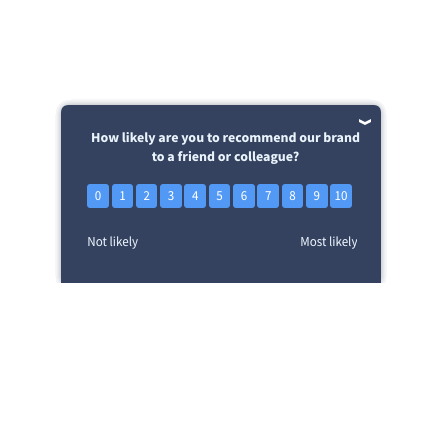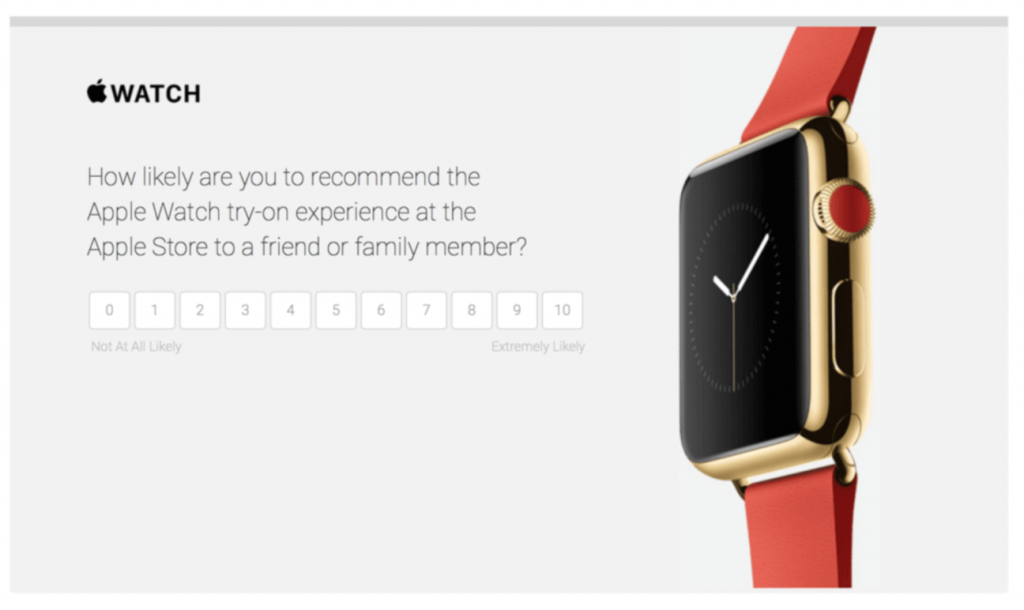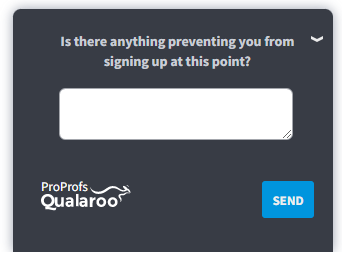A Net Promoter Score or NPS collected with NPS survey tells you where you stand with customer loyalty — but it’s what you do with that score that determines how you’ll grow.
You learn how to build up your customer base when you find out the reasons for each score.
You learn how to delight your passive customers before they churn and abandon you for your competition.
Your promoters’ feedback helps you learn how to boost customer referrals so that you can increase sales.
Paying attention to detractors also helps you save by a huge margin considering that it’s way more expensive to acquire a new customer than retaining an existing one.
And, when you close the loop, you have a greater chance to discover critical mistakes that are preventing your detractors from becoming your biggest promoters.
In this blog, we’ll break down how to follow up specifically with detractors to improve customer retention.
A Brief Definition of NPS
Watch: What is NPS Score & why do you need it
The Net Promoter Score(R) is a registered trademark of Bain & Company. It is a quite simple yet valuable benchmark as it tells you the percentage of people who are likely to recommend your brand.
It is a straightforward question:

People share the likelihood on a scale from 0 to 10, and NPS is calculated as shown below:
- The ‘promoters’ category is happy with your services and can recommend you to others.
- The ‘passives’ are neither here nor there.
- But the detractors are most likely to switch to your competitor if you don’t do something about it.
As you can see, NPS(R) is pretty simple. You can compare your NPS(R) against industry benchmarks and use it (if it is good enough) to promote your brand to new customers.
More importantly, though, it gives you a great opportunity to discover the ‘why’ behind certain people’s (i.e., detractors’) dissatisfaction and take concrete steps to address their concerns.
Watch: Qualaroo NPS survey recipes
Why You Should Follow up With Detractors
Your detractors can do more harm than the good that even your most loyal promoters do — detractors are twice as likely to spread negative comments than your promoters to share positive experiences.
Detractors may damage your reputation and your bottom line, which is why you need to have a follow-up plan for them.
When you reach out and act on their problems, you’re more likely to keep them as a customer — and also keep them from scaring potential customers away.
How to Identify Detractors
Amy Trus, Senior Lifecycle Marketing Manager at VideoBlocks, noticed that detractors were the most engaged with marketers who reached out to them. They were more than willing to share what’s wrong and how they’re trying to use your product – this is valuable info you need!
There are more examples that show how detractors can be your greatest opportunity to learn about improving your product. If they have a specific issue you can address, this is your chance to show that you care, impress them, and increase their loyalty by solving their specific problem.
Types of Detractors
You wanna know what you’re up against before building a strategy, right?
Dealing with detractors isn’t a one-size-fits-all approach. You’ll certainly fare better while dealing once you know how every type of detractor differs from each other. So here are the types for reference:
Cancelers: They’ve already decided to cancel and want you to know why
Frustrated buyers: They are frustrated and actively researching and considering alternatives but haven’t decided to cancel yet
Disappointed buyers: Certain aspects of your product or a single interaction have disappointed them, but they still think your product or service has potential and want to help you improve it
Complainers: They use your product out of necessity and aren’t actively considering switching to an alternative but want to voice their complaints and criticism.
FREE. All Features. FOREVER!
Try our Forever FREE account with all premium features!
How To Follow up With Detractors
Make an effort to ask for more feedback from your detractors.
Example:
Cara Herrick, Customer Success Manager at Drift, sends the email shown below to detractors. When you go above and beyond to address issues without selling them anything, it shows you truly care about their experience.

You can see that the words you use, their tone, and how you ask a question to the detractor can greatly affect customer perception. That is why it is essential to follow up with detractors in an empathetic way that relates to their position and makes them feel valued.
To do this, reach out to them over the phone or email to discuss any problems they’re facing. Make them feel included in your product roadmap during your follow-up discussion.
For example, if you’re certain that their current problem is solvable with a future update in your product, you can offer a sneak peek of that update and invite them to beta test it when it is available.
You can integrate feedback software like Qualaroo’s NPS data with Slack to notify your customer happiness team as detractor ratings are routed to a dedicated @customer-happiness handle. That way, your customer service team can delight detractors by quickly responding to their issues.
READ TO KNOW MORE:
The Best Ways Big Companies [Apple, Salesforce, Trader Joe’s] Use Customer Feedback

Following up With Detractors: Dos and Don’ts
Let’s discuss what you should and shouldn’t do while following up with detractors.
1. Choose the Right Time
The success of your follow-up depends majorly on when you follow up with the respondents. The sooner you contact the detractors regarding their NPS responses, the better you can gather fresh insights about detractors’ experiences.
You should follow up at least within a week of collecting the responses while the experience is still fresh, else it will be too late. The customers won’t remember the crucial details of their experience and why they gave the ratings.
If you follow up promptly, you won’t lose your momentum and will be able to help detractors with their issues and problems.
Related Read – Here is our list of Best NPS and Survey Tools in 2026
2. Get the Context and Understand Their Type
The first thing any customer-facing support person should do is to learn about the customers they will contact. Before sending a follow-up email or call, understand the customers’ experiences with the company.
For instance, check up on support tickets, conversations with sales teams, support for product usage, surveys they might have filled, and thoroughly read their comments in those surveys to get a hint of how they feel towards the company and its services/products.
Once you know the history of these customers with the company, their ratings will make more sense, and you can help them with personalized solutions and turn them into promoters.
3. Put a Game Plan in Place
You can’t just go blind and shoot a follow-up email or a phone call without any idea of how you will handle the situation. You need to set an outcome you expect from this follow-up and how you will turn the detractors into loyal customers.
Will you go with hard-selling or focus more on what customers require and resolve their issues?
As explained above, once you have done your homework on the customers, you will know the right moves to make.
For instance, if a customer has requested specific features, you need to follow up with the product design team and get an update on the same. If a customer needs help with a particular feature or process, pull out your instructions sheet and help them with it.
If the customer is highly disappointed to the point of being angry, would you offer an apology or offer them some kind of monetary benefit like a discount? These strategies should be planned and improvised during the follow-up to bring detractors back to the promoters category.
4. Tell Them the Purpose of Following Up
When you contact the customers, they are curious to know why you contacted them. They don’t want to waste their time, so the sooner you introduce yourself and your purpose for contacting them, the better the chance to have a conversation with them.
While introducing your purpose, do not:
- Call them a detractor to their face.
- Tell them you are following up on an NPS survey.
- Be overly promotional and tell them you want to make them happy.
So, if you can’t tell them the real purpose of the follow-up, what should you tell them?
You can introduce yourself and your company and let them know you are following up on a recent survey. You can say that you would like to talk about their overall experience with the company without mentioning anything about NPS.
5. Ask More Questions
The purpose of following up on the NPS survey is to get deeper insights and context behind the score beyond what respondents told you in the survey.
Once you know customers agree to have a conversation, begin by asking about their overall experience with the product and the company. Besides this, you need to ask them other questions to get more details. Such as-
- Are they simply unhappy with your offerings?
- Do they prefer a competitor over you? Why?
The question is, what type of questions will get you the desired answers? Here is what you should do –
- Use open-ended questions
- Customize the questions based on the score
Ask them how they use a product/service and what they expect more. If the issue is with the usage, you can help detractors then and there to win them back. Make sure to record the conversation if you are calling them for a follow-up so anyone can refer to this conversation in the future.
You can also ask such questions by email, but you can get deeper insights by directly talking to them over the phone.
6. Take Their Concerns into Account
While they share their experiences with the company and what problems they faced that made them give low ratings, start making points of their concerns, so you do not miss any.
Once you have a clear list of customer issues, you can either solve them instantly, apologize for the lousy service and experience, and assure them that you will actively address the rest of the issues.
You can assure customers that they are being heard by telling them what you will do next to resolve their issues promptly.
7. Find Out What You Can Improve to Make Them Stay
You must not disclose that the intent of your follow-up is to make them stick, but you need to know what improvements they would like to see in the product, service, or customer experience.
Once you know their expectations and pain points, you can gain their trust back by actively working on making their experience flawless.
8. Offer Discounts or Gift Codes to Retain Them
Judging by how the conversation is going, you can offer customers discount coupons or gift cards for the bad experience if you feel like they need more convincing.
It’ll increase your chances of making them stay so that you can work on improving their experience in the future.
9. Follow up, Again
When customers have opened up and shared their experiences and concerns, you need to make sure you resolve all of them. If you can’t resolve some issues promptly, make sure to add them to your priority list and get them resolved at the earliest.
You can add customer information to whatever system you use for recording ‘to do’ tasks and inform customers when you have an update. It will make the customers feel heard and that they matter to the company.
This positive experience will go a long way and will make the detractors reconsider staying with your business.
*Note: If you tell the customers you will follow up, make sure to do so. If not, you will further disappoint the detractors, and they will probably share their experience with others, spreading bad word-of-mouth, which is the worst nightmare for all companies.
10. Keep a Track
After you have talked to the detractors, understood their problems, and actively worked on resolving them, now is the time to check if all that was successful or not, i.e., were you able to turn them into promoters or not.
So, a simple follow-up via a call or an email after a couple of months would offer you these insights. If your efforts improved detractors’ customer experience with the company, they will stick with you.
How to Convert Detractors Into Promoters
Now that you know what to do and what not to while approaching detractors, here are a few tips on how you can turn them into your loyal promoters.
- Promote Feedback Sharing
73% of customers feel that valuing their time is one of the best services companies can offer.
Instead of waiting for customers to come to you with complaints and feedback, go with the proactive approach. First, ask the customers what they think about the company or its products and services, how much they would rate their customer experience, and if they will recommend you to others.
Show the customers you care about their feedback and will work on it instead of just collecting it for the sake of it.
The voice of customers matters a lot for a company, so make the customers feel they are heard and that a company values their feedback and time.
- Sweeten the Deal as They’re About to Leave
Right after customers or visitors to your website take a survey and give a low score, you can make sure that their exit is another chance to make things right. Apart from live chat popups, you can also launch exit popups using tools like Picreel on your website that enable you to send targeted offers right when the prospects are about to leave.
- Encourage Customers to Contact You
Another way to collect customer feedback and help detractors with their issues is to allow them to contact you.
More often than not, unsatisfied customers don’t even share that they’ve had a bad experience (or a series of them) with the company and just leave to do business with the competitors. Due to this, companies don’t even get a chance to make it right and retain detractors.
You can opt for multi-channel customer support so that customers can contact you in any way they see fit, for example, social media platforms.
Related Read – Here is our list of best Customer Feedback Tools in 2021
- Respond Promptly to Delight Detractors
Apart from being proactive, you need to be prompt as well. Nothing is more frustrating for customers to wait for customer support for their issues.
The need to be prompt with your responses is even dire in detractors’ cases as they are already highly unsatisfied.
Even a little bit of delay can push them towards your competitors. Being timely with your responses also shows that you care about your customers’ problems and actually want to help them, which builds trust.
- Don’t Make the Promises You Can’t Keep
We briefly mentioned in the article before that only promising detractors that you heard their concerns and will resolve them will not get you anywhere.
If anything, the already unsatisfied customers will become even more frustrated with the brand since you haven’t done anything to help them. So, don’t just make promises to help them and actively be a part of the solution.
- Close the Customer Feedback Loop
To what we briefly mentioned in the article before, simply collecting feedback for its sake will not help you convert detractors in any way. For that, you must close the feedback loop, meaning you have to ensure that actions are taken on the feedback, and that customer issues are being resolved.
Ensure that there are no feedback data silos and every department is aware of what they need to do based on the feedback. Once you have an update on the suggestions or issues raised by the detractors, you should update them on the progress.
This way, detractors know that their feedback is not just a part of heaps of feedback data and matters to the company.
NPS Follow up Templates and Questions
Qualaroo’s advanced targeting and logic branching let you ask different follow-up questions depending upon the score given by the respondent. As we’ve elaborated above, 0-6 scorers are detractors.
When your NPS(R) survey identifies a detractor, ask them an open-ended question:
Question 1: “We’re sorry you feel that way. May we know how we could be better for you?”
Put the answers through Sentiment Analysis (powered by IBM Watson’s Artificial Intelligence).
This question encourages people who aren’t particularly happy with your brand to share the reason(s) behind their unhappiness or dissatisfaction, and you can then try to fix those reasons.
Another question that invites detractors to convey their feedback in the form of advice is:
Question 2: “What do you think we should do to improve?”
Since this question asks for their personal opinion, they might be more willing to share. This question draws upon the concept of making the detractor feel that they are knowledgeable.
In case you have a product that is quite feature-heavy, and you feel you need to find out which features may be causing users problems (hence their low scores on the survey), ask them this:
Question 3: “Which features are most useful for you?”
You can simply ask detractors for their feedback or idea if any:

Question 4: “What feature do you want us to include in our product/service that our competitor has?”
This question is directed towards passives to gauge what more they expect so you can deliver it and turn them into promoters. You can also look for request patterns and include the features that are frequently mentioned in the feedback.
Question 5: “If you could change any one thing in our product, what would it be?”
The responses to this question will offer different insights that you can incorporate to improve the customer experience. The customers will be encouraged to think and share ideas on what to improve, issues they face, or what you are doing wrong, i.e., sending too many surveys.
Related Read – Here is our list of 20 Best Customer Experience Management Software in 2021
Question 6: “What is the one thing we could do that would make you happier?”
This question helps close the feedback loop as it shows your customers or detractors that you care about their happiness and success when using your product or service.
The feedback from this question can help Customer Success managers to develop deeper customer relations as they can act on the feedback and turn detractors into promoters.
Once you have sent in your survey and got the feedback from the customers, you should work on a ‘Thank you message’ you need to send at the end of the survey.
Check out our survey question library to explore more questions that you can ask based on different scenarios.
FREE. All Features. FOREVER!
Try our Forever FREE account with all premium features!
Thank You Messages to Send After Conducting Survey
Keeping it humble is an excellent way to show you value customers and their time. One way to show your gratitude is to send a thank you message once they finish taking your survey.
Here are some template examples of thank you text you can send based on the net promoter score customers give.
For Promoters
“Thank you for sharing your feedback. It is great to hear that you’re a fan of (our company or product/service). Your feedback is a rich source for us to explore new opportunities for improvement (in our company or product) and make sure you have the best experience with us.”
For Passives
“Thank you for your feedback. We aim to design the best possible product, and your feedback and ideas are essential for us to identify opportunities to improve.”
For Detractors
“Thank you for sharing your valuable feedback. We highly value all suggestions and criticism from our customers. Our team might reach out to you in the future to learn more about how we can improve (our product or service) for you so that it exceeds your expectations and improves your experience.”
So far, we have covered the questions you can ask in your NPS survey and how you can express your gratitude to customers for taking the time to complete the survey. It’s only natural that we now cover how you can follow up on your NPS.
Follow up Templates to Ask the Right Questions
Let’s see how you can follow up on your NPS survey depending on the category of respondents, i.e., Promoters, Passives, and Detractors.
You can automate follow-up emails with these templates and customize them as per each customer. You can use Zapier integration with Qualaroo to automate these follow-up emails easily.
For Promoters
Email subject: “What do you like most about [company/product_name]?”
Text: “Hi [first_name of customer or ‘there’],
We are ecstatic to know that you are happy and satisfied with our [company or product], and would like to keep it this way and improve further. Could you please tell us what you like the most about our [company or product]?
We would appreciate and love to hear your thoughts. Thanks for your valuable feedback!”
For Passives
Email subject: “What can we improve in [company/product_name]?”
Text: “Hi [first_name of customer or ‘there’],
Thanks for responding to our survey. Your response shows that we need to improve and can do better. We would highly appreciate it if you can tell us what we should improve to enhance your experience.
Looking forward to hearing what you think.
Thank you for sharing your feedback!”
For Detractors
Email subject: “What can we do to improve your experience at the [company_name]?”
Text: “Hi [first_name of customer or ‘there’],
We are deeply apologetic to know you are not fully satisfied with our [company or product]. We strive to improve and prove to be a better fit for your business needs and requirements.
We would highly appreciate it if you can tell us what we did wrong and what we can do to improve?
Looking forward to hearing your suggestions and thoughts.
Thanks for your feedback!”
Detractors are just one of the three categories of NPS respondents. What about the other 2?
We’ve got you covered.
How to turn your passive fans into active promoters:
Passively satisfied customers aren’t necessarily “good” even though they fall closer to the promoter end of the NPS spectrum. They don’t hate your product, but they don’t really love it either. If you overlook them, they’ll overlook you and leave in 6 months when a better offer comes along.
Your passive customers are price-sensitive, which means they’ll switch to competitive products with similar features to yours just to get a better price. You have to target more than the price and show that you offer a better experience. You can offer them a free extended upgrade, so they stick around long enough to have a better “taste” of your product.
When you offer this upgrade, you want to mention that this doesn’t carry any risk and show them value. That’s the thought behind this email that Michael Xu, Chief Momentum Architect at Strikingly, sends to extend the trial period for Strikingly Pro customers. You can adapt this upgrade offer for a survey follow-up with your passive customers.

But even after their extended trial period ends, you want to follow up with your passive customers to find out how they felt about using your product during that time.
For example, you could ask them to share what they liked or disliked about your product during that trial period. When you ask both sides what passives like and don’t like, it encourages them to provide stronger feedback that helps you learn how they were trying to use your product.
You’ll determine which features will convert so that you can focus on those in your onboarding. And you’ll learn what parts of the onboarding experience need to be improved so you can reduce churn.
With an email tool specializing in segmentation, like Customer.io, you can target customers who rated you 7 or 8 and signed up for your extended trial offer. Then, you can trigger a follow-up campaign when their trial is about to end.
How to turn your promoters into repeat revenue:
Only about 20% of your promoters will actively refer to your product without you asking them to. If you don’t reach out to them for testimonials, you could be leaving potential revenue unused.
A simple way to do this would be thanking your loyal promoters and asking them what they value the most about your product. If they tell you why they gave you a high score, then the chances are that they would be happy to share those positive comments about your product. So all you have to do is ask for permission to use their feedback as a testimonial on your site.
Alex Turnbull, CEO of Groove, made it easy for promoters to share their story through a phone discussion or by answering two questions in this email. Providing sample questions as he did reduces friction, so they’ll be more willing to share their positive experiences.

You can further strengthen relationships with your promoters and encourage word-of-mouth referrals by rewarding them for their testimonial with your company’s branded swag. Printfection will print your company swag on demand. It integrates with Zapier, so you can automatically send free gear to your loyal promoters who complete your NPS survey and leave a review.
Sending swag drives even more revenue because your loyal promoters will effectively act as advertisers for your brand.
Roadmap to Create an NPS Program
By now, you know what you should do once you get the NPS feedback from your customers and how to follow up on the respondents. With that said, let’s see how you can create an effective NPS program for your business.
Watch: How to Create Net Promoter Score Survey
- Design a Customer-Centric Culture to Increase Accountability
Thinking of customers in mere numbers furthers a company from being customer-centric. Companies need to see customer experience and human experiences and not just numbers on a dashboard.
A customer-centric culture promotes talking to the customers one-on-one so that you can relate and empathize with their issues and understand what you need to improve. For instance, you can see via numbers that few of your website pages have high bounce rates, but you’d know how and where to improve only after talking to customers.
- Develop and Implement the NPS Survey
To begin with, you need to create effective NPS surveys with questions that can procure deep insights from your customers. Once you know what and how to ask, you can design an NPS survey with tools like Qualaroo and implement it on your website to start collecting the scores right away.
- Use a CRM to Integrate NPS
Using a CRM to integrate your NPS score helps keep track of the customer feedback and what issues a particular customer has talked about with the support. It helps customer service reps and sales reps to look into a ticket in detail and help resolve their issues efficiently.
For example, if a detractor with a net promoter score of 5 calls, it’ll be easy to track their issue and work on it to enhance their experience and turn them into a promoter.
- Assure Them You Are Always There to Help
What we mean by this is once you follow up with a detractor, empathize with their concerns, help them with their issues, and close the feedback loop, they will be left with a positive experience with your company.
Assuring that they will always have someone from the company to listen and help with their issues in the future as well will encourage them to stick with the company.
- Ensure a Closed-Loop CX
Again, closing the feedback loop is crucial to a successful follow-up. You don’t want to leave the detractors hanging. Once you know their pain points, assure them that you will look into it and update them on the improvements. It will let them know that you are eager to improve their customer experience.
- Stop Internal Issues Before They Become Unsolvable
Sometimes, the issues customers convey in the feedback are symptoms of something internally wrong in the company. If you see a pattern in scores or customer feedback that points to certain recurring issues, you need to perform a root cause analysis to see if the problem is endemic to your business operations.
By performing the root cause analysis, you will be able to figure out what you need to improve internally to start working on them and stop customers from churning.
- Predict Churn
Under the churn prediction model, you analyze the existing response data from surveys (Net Promoter Score, Customer Satisfaction Survey (CSAT), Customer Effort Score (CES), exit-intent, etc.) and find trends or patterns that point towards a customer turning into a detractor.
For example, suppose you notice a customer giving a low NPS score. In that case, you can check their interaction history with the company (from the data integrated into a CRM) and follow up on them to understand their experience. This way, you will know how you can help them and stop them from churning.
Based on the red flags noticed from this interaction, you can identify other unsatisfied customers and assist them proactively before they turn into detractors.
Uncovering the Hidden Advantage of Your Biggest Detractors
Steve Jobs had rightly said,
“Get closer than ever to your customers. So close that you tell them what they need well before they realize it themselves.”
When you follow up with NPS survey scores, it’s one way to get closer to all of your customers, whether that’s your most negative detractors or your most positive promoters. You can use their valuable feedback to detect and address their needs to keep them as a customer.
But you’ll do more than discover valuable insights to address their needs. You’ll build loyal customer relationships when you’re able to resolve the problems that matter most to them. And it will remind your customers of the good things they enjoy about your brand the next time they think about endorsing you to people they know.
FREE. All Features. FOREVER!
Try our Forever FREE account with all premium features!


 We'd love your feedback!
We'd love your feedback! Thanks for your feedback!
Thanks for your feedback!







